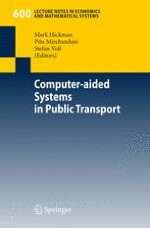2008 | OriginalPaper | Chapter
Schedule-Based and Autoregressive Bus Running Time Modeling in the Presence of Driver-Bus Heterogeneity
Authors : Rabi G. Mishalani, Mark R. McCord, Stacey Forman
Published in: Computer-aided Systems in Public Transport
Publisher: Springer Berlin Heidelberg
Activate our intelligent search to find suitable subject content or patents.
Select sections of text to find matching patents with Artificial Intelligence. powered by
Select sections of text to find additional relevant content using AI-assisted search. powered by
Bus route running time represents a key element of transit performance. An understanding of running time behavior and the factors that influence it is essential for off-line planning and operations design purposes including fleet size planning, schedule design, and passenger travel time performance assessment. Such an understanding is also critical for realtime applications including bus operations control and passenger information systems. This paper focuses on developing models of running time and estimating them using field data. Two model structures are considered. The schedule-based model specifies the upcoming running time as a function of the most recent deviation from the schedule the bus has exhibited at the terminus. This model characterizes the situation where a late running bus attempts to catch up with the schedule and, hence, reflects an upcoming running time shorter than the target running time, and vice versa. The autoregressive model specifies the upcoming running time as a function of the most recent running time. This model characterizes one of two situations depending on the sign of the parameter estimate. On the one hand, when the most recent running time is longer than the mean, the upcoming running time would also be longer than the mean if the operation is dominated by exogenous factors that cause delays such as other traffic or weather. On the other hand, the upcoming running time would be shorter than the mean if the driver is capable of speeding up to reduce the delay in the operation. Irrespective of the model structure, the characteristics of the driver-bus pair may also influence the extent to which the upcoming running time will deviate from the target or the mean. To capture this potential heterogeneous phenomenon, the fixed effects formulation is adopted whereby driverbus pair dummy variables are included in the model. Field data are utilized in estimating the two types of models in the presence of driver-bus heterogeneity. In general, the schedule-based model is superior to the autoregressive model in describing running time behavior. Moreover, driver-bus heterogeneity is found to be a significant contributor to this behavior.
